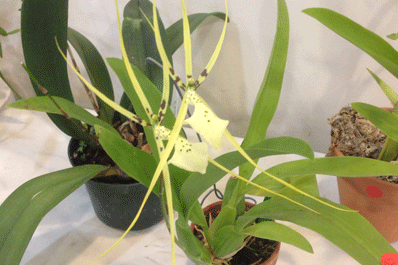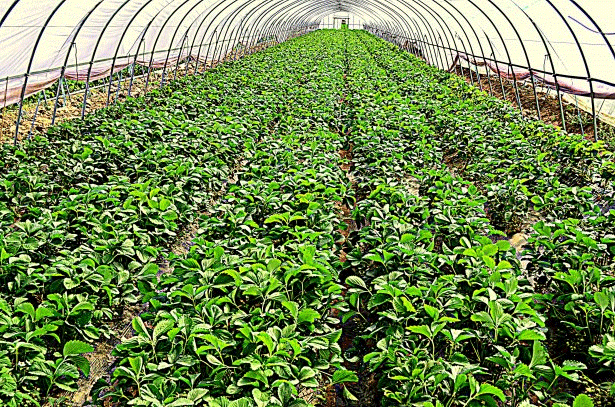
Preserving orchid species in native habitats and in clubs
Yes, we have to do all we can to practice orchid conservation by supporting groups who preserve natural habitats . That’s the most important thing. At the same time, we have an opportunity to preserve species whose natural habitats are already gone. How does that work?
In a recent conversation about conservation a fellow club member mentioned the importance of taking good care of our own collections to preserve valuable species. I agreed, and decided that it’s time for me to learn about Ex Situ conservation.
I was aware of one method, seed banks, but needed information about their rate of success.
Orchid clubs can work together to preserve species by sharing plants from their collections.
Another method, “private collections”, is one that we practice in our club. Our auctions are an excellent way for each of us to farm pieces of our collections to other members. By having a clone of a specimen in more than one location, that plant’s odds of surviving are increased. A power outage during a winter freeze, or during an especially brutal summer, can damage or even destroy an entire collection. By distributing our plants among each other we increase the odds of survival.
But just how important is this concept when carried out long term or on a larger scale? In researching this topic I turned to a reliable source “Orchids and their Conservation” by Harold Koopowitz (2001).
‘In situ’ vs. ‘ex situ’ conservation – both are important
To begin with, preserving orchids in their natural habitat (In Situ conservation) can work only if that habitat still exists. For most of our important species, these habitats are gone, and many species remain only in collections. So, for many species, Ex Situ conservation is all we have. So, yes, these species of ours are important.
 At the genetic level, however, preserving a few species in a collection misses the ideal goal of preserving the original gene pool, although it is still better than nothing. Koopowitz says that a rule of thumb is that “50 randomly selected individuals contain 95% of the genetic variations of the population”. It would take at least 500 to a thousand plants to really preserve the species going forward. Obviously at our individual level of growing, we have to forget that goal. Not even the biggest and best collections have been able to achieve that. And often, too, only a few of the rarer species even exist.
At the genetic level, however, preserving a few species in a collection misses the ideal goal of preserving the original gene pool, although it is still better than nothing. Koopowitz says that a rule of thumb is that “50 randomly selected individuals contain 95% of the genetic variations of the population”. It would take at least 500 to a thousand plants to really preserve the species going forward. Obviously at our individual level of growing, we have to forget that goal. Not even the biggest and best collections have been able to achieve that. And often, too, only a few of the rarer species even exist.
Private collections can play a very important part in the big picture of conservation
Some large collections in the past have been set up for conservation. Unfortunately, all too often a lack of funding, a change in ownership, and loss of key personnel have spelled doom for a collection’s continued success. Kew, which I have always thought of as the gold standard for gardens, has only 5000 species of orchids, and the average long term survival rate of any plant is less than 10%.
Perhaps this low survival rate can be explained by the fact that Kew’s purpose has tended more heavily toward research rather than conservation. And, consider that even with adequate funding and good care, orchids just don’t tend to survive well past 30 to 50 years even in the best of hands (although there are cases of orchids who have made it to the century mark).
Alternatives that have proven effective include preserving species in seed, gene and tissue culture banks. This has been done for our important agricultural crops, such as rice and corn, with good success. Every few years the seeds are planted out and the seed stock is refreshed.
Preserving orchid seeds is neither simple nor reliable – live plants are the best bet for preserving species
Orchids are less fortunate, in that for many species their seeds remain viable for many only a few weeks or months. (Seeds from terrestrials are reportedly last longer.) Temperature and the amount of moisture in the seeds are prime factors to the seeds’ viability. The cooler and dryer they are, the longer they will last.
Research experiments with freezing seeds has produced mixed results. In the 70’s and 80’s, when seed banks for wild flowers were getting started, a project was launched for orchids when some studies showed 3-year viability with -10 degrees C. But then the 8-year data came in, and all seeds were dead.This was a crushing blow to a program that had even been advertised in the AOS bulletin as ready for prime time.
In the 1990’s Koopowitz conducted on plotting longevity at different temperatures. Despite some good outcomes, but he recognizes that more work needs to be done. He recommends that “setting up carefully controlled, long-term sub-freezing experiments should be the top priority of the orchid conservation community.” Further stressing the importance of Ex Situ conservation, he goes on to say that we would be lucky to preserve 50% of the species with In Situ preservation and even a lesser percentage of the biodiversity to keep it going.
A brief internet search reveals a number of seed bank programs that focus on the collection and redistribution of seeds to growers or repopulating the natural habitat. This approach appears to be a good method to capture the maximum amount of diversity while the long term storage awaits a solution. Like so many of the problems we face with all aspects of our future existence, it may take multiple solutions to keep orchids available for future generations.
Here is where local orchid societies can play a big part in conservation efforts
What can we do? We can pass divisions of our special orchids to friends and follow the success of the orchids in their new home. On several occasions, I have received plants from friends who felt my greenhouse would be a better environment. And conversely, I have friends who have done better with my divisions.
Whenever we bring divisions to our club auctions we should remember to identify the source, so that new owners will know where the cultivar came from. Also, it’s a good idea to keep a record of who ends up with your contribution. Finally, we need to make plans for the disposition of our collections, should we be unable to care for them at some point. This way our plants will continue to receive the loving care and attention they need in order to thrive and bring joy to future generations of orchid lovers.